Whitley Strieber
2012: THE WAR FOR SOULS
PART ONE
And a Darkness over the Earth
The Soul that rises with us, our life’s Star,
Hath had elsewhere its setting
And cometh from afar;
Not in entire forgetfulness,
And not in utter nakedness,
But trailing clouds of glory do we come
From God, who is our home.
—WILLIAM WORDSWORTH “Ode on Intimations of Immortality from Recollections of Early Childhood”
There is no supernatural. There is only the natural world, and you have access to all of it. Souls are part of nature.
—The Master of the Key
PROLOGUE
NOVEMBER 21
DARK LENS
MARTIN WINTERS HAD BEEN IN the Pyramid of Khufu a number of times, and he’d always felt the same wonder and the same claustrophobia. The work he was doing here was revolutionizing archaeology, and that was exciting, but this particular journey into the tiny pit beneath the structure was one he had been dreading.
His mission was to collect stone facing from the interior of joins, so that the new technique of mass-average decay dating could be applied and a final mystery solved. Over the past three years, his lab at Kansas State University at Uriah had dated a dozen sites in South America using the technique. For the past nine months, they had been working on the Great Pyramid, and the results were so inconsistent that archaeologists worldwide, eager to dismiss findings that had devastated their theories about the past, were howling that the technique was defective.
What they had found was that the pyramid had not been built in just a few years, but that the work had been done in at least four stages over thousands of years, beginning at least six thousand years ago. The Fourth Dynasty pharaoh Khufu had indeed built the section where his glyph had been found, but the pyramid rested on a base that had been laid three thousand years before Khufu’s reign.
Now it was time to address the pit beneath the pyramid, believed to be an earlier burial chamber. It was here that he expected to finalize his study of the Giza plateau, because this was thought to be the first human work that had appeared on it.
He had also worked on another site, a very ancient building called the Osirion, where rituals involving the Egyptian resurrection deity Osiris had been practiced.
His findings were so explosive that he had not yet published them. He wasn’t willing to expose his technique to the howls of criticism that would come when his proof that it had been constructed between 18,000 and 20,000 years ago was revealed. He’d also explored dating the Sphinx, but it was carved out of a solid block of limestone, which left him without anything to sample. He needed tiny fragments of stone that had been struck by quarrymen’s tools, then soon after pressed against other stone and not moved since.
Before him, the descending passage awaited. The government did not allow the public to go into the pit, and for good reason. More than one visitor had been carried out in a state of panic, and the air was so bad that suffocation was a definite issue. Legends about the place suggested that it had been used by some of the Egyptian priesthoods as an initiatory chamber, presumably where people were taught to overcome whatever fears it caused.
“Okay,” he said, testing his flashlight. Then again, “Okay.”
Ahmad Mahfouz chuckled. “Okay.”
“You bastard, you go down.”
Ahmad laughed aloud. “It’s not my machine that’s driving everybody crazy.”
Ahmad was not only one of the finest archaeologists in Egypt, he had an excellent mind for technology, so he understood why it was most unlikely that mass-average decay dating was wrong. It was, in fact, the holy grail of dating techniques: it could tell when stone was last worked, as long as the stone had not been exposed to air, thus the need to go deep into structures like this and drill into joined stones in order to get samples.
In Peru, where the Incas had fitted their stones with a jeweler’s precision, this had been easy. In the pyramid and the Osirion, it had entailed careful drilling using sonar guidance. Here, also, so he was loaded with equipment.
The descending passage was narrow, it was pitch black, and madness stalked the people who went down.
“Radio check,” he said as soon as he was ten steps in.
“We don’t need it yet, Martin. I’m right here.”
“I’m sorry, Ahmad. Look, if I get out of here alive, you’re buying.”
“It’s been there for thousands of years—far longer than anybody thought, according to you. So why would it pick today to collapse?”
Feeling like an idiot, Martin headed deeper. Soon, a silence enveloped him that was unlike anything he had ever known, and he had been in some very quiet holes in the ground.
What was different about this silence was that it felt, he thought, aggressive. Like it knew you were there and had been waiting, and now it wanted you. Like it knew.
But, of course, that was all in his mind. There was no malign presence here—or anywhere else, for that matter. No ghosts, no gods. This was simply what happens when you descend a narrow tunnel beneath six million tons of stone.
One thing the ancient Egyptians had not been were fools. They had understood this effect, which might be why the pit was here. The conventional wisdom was that it was an old tomb, but that wasn’t at all clear. Half of it was an odd, roughly constructed platform with rocky knobs on it. Certainly no place for a sarcophagus, and the rest of the room was just as strange, being dominated by a diagonal cut in the floor about six feet deep. It was, in fact, in the walls of this pit that Martin hoped to find the fitted masonry that was crucial to his success.
He reached the chamber itself. He was now eighty feet beneath the pyramid’s foundation. The air was thick and cool, clammy, even. His multi-gas detector was telling him that although carbon dioxide levels were high, he was basically safe. He carried an emergency respirator with an hour’s supply of oxygen, more than enough to enable him to withdraw if he used up all the air in the confined space. Or, if the worst were to happen, to suffocate more slowly.
“I’ve arrived,” he said into his radio.
There was a silence. A long silence.
“Mahmoud!”
“Oh, sorry, effendi. I was taking my lazy tea.”
“I’m scared down here, man!”
“And I know it, and I’m trying to make some fun for you.”
He was a great guy and a fabulous scientist, but there was a cultural gulf between a Moslem who had grown up when this was still Turkish territory, and now had to deal with the Brits. “Remember, I’m an American,” he said. This was not the time for practical jokes with the radio.
He took a deep breath, then another. Then he opened his equipment bag and pulled out the radar. It could penetrate limestone to a depth of ten feet, and return detailed imagery of what was there. It could, in other words, locate the joins in masonry construction.
His plan was to send his tiny drill in about an eighth of an inch behind a join, then collect stone right off the join itself.
He did not shine his light around. He knew what was there, and he didn’t want to see just how close the walls were. The ceiling was ten feet, though, so he was no longer being forced to hunch as he had when he was in the passage itself.
Back problems were the archaeologist’s curse. You couldn’t work without hunching and bending, often for hours, often in confined spaces, and the older you got, the more you became aware of this. At thirty-four, he wasn’t feeling it much, not with swimming, squash, tennis and—well, Lindy. No, he worked his back plenty, and had two children to show for it at home. He also had a wife who was working to get one of the most extraordinary jobs in the world. Since 2010, when NASA had announced that some UFOs were indeed intelligently guided craft, perhaps extraterrestrial or perhaps from a parallel universe, the International Advanced Propulsion Physics Seminar had been working overtime to understand how they worked.
Читать дальше












